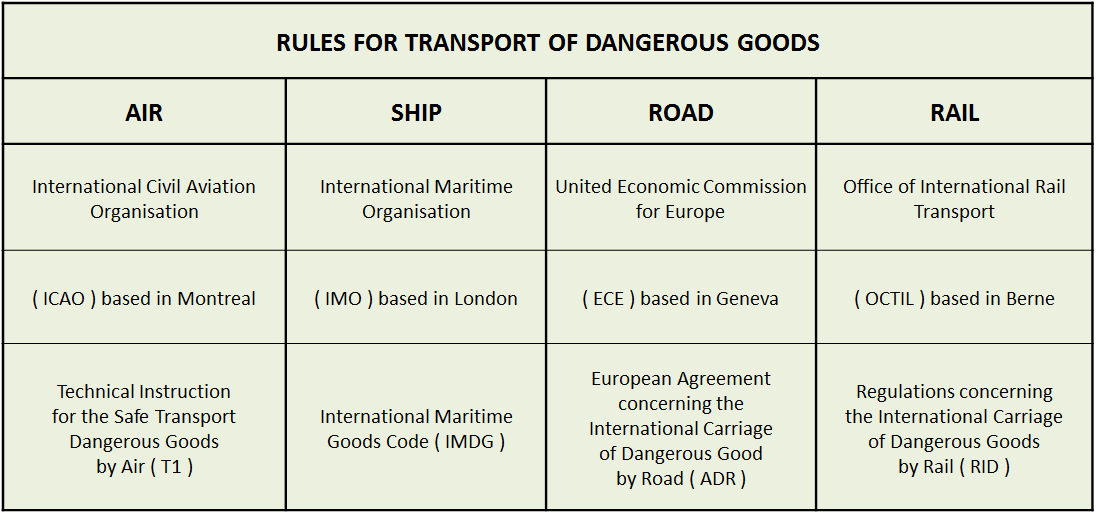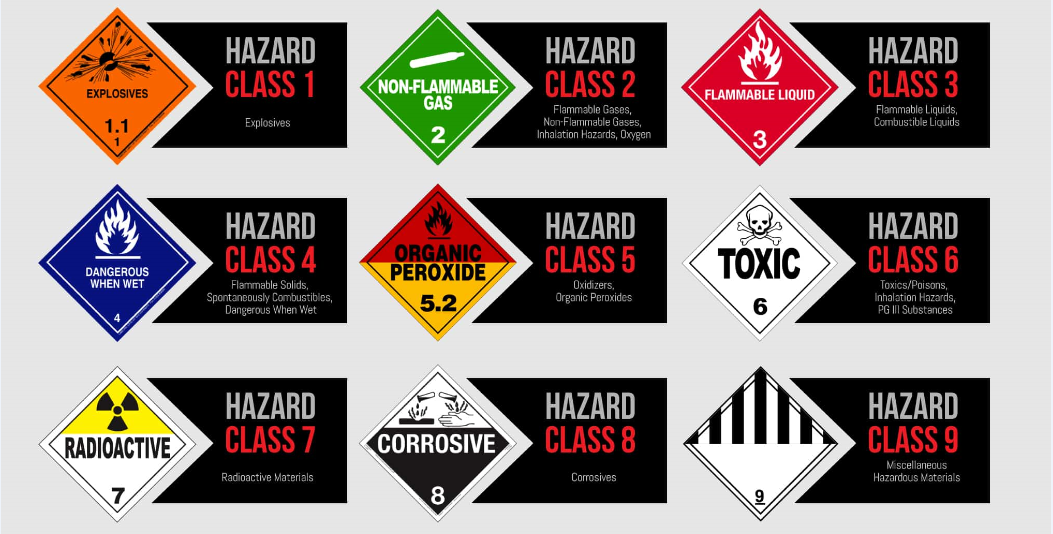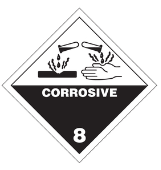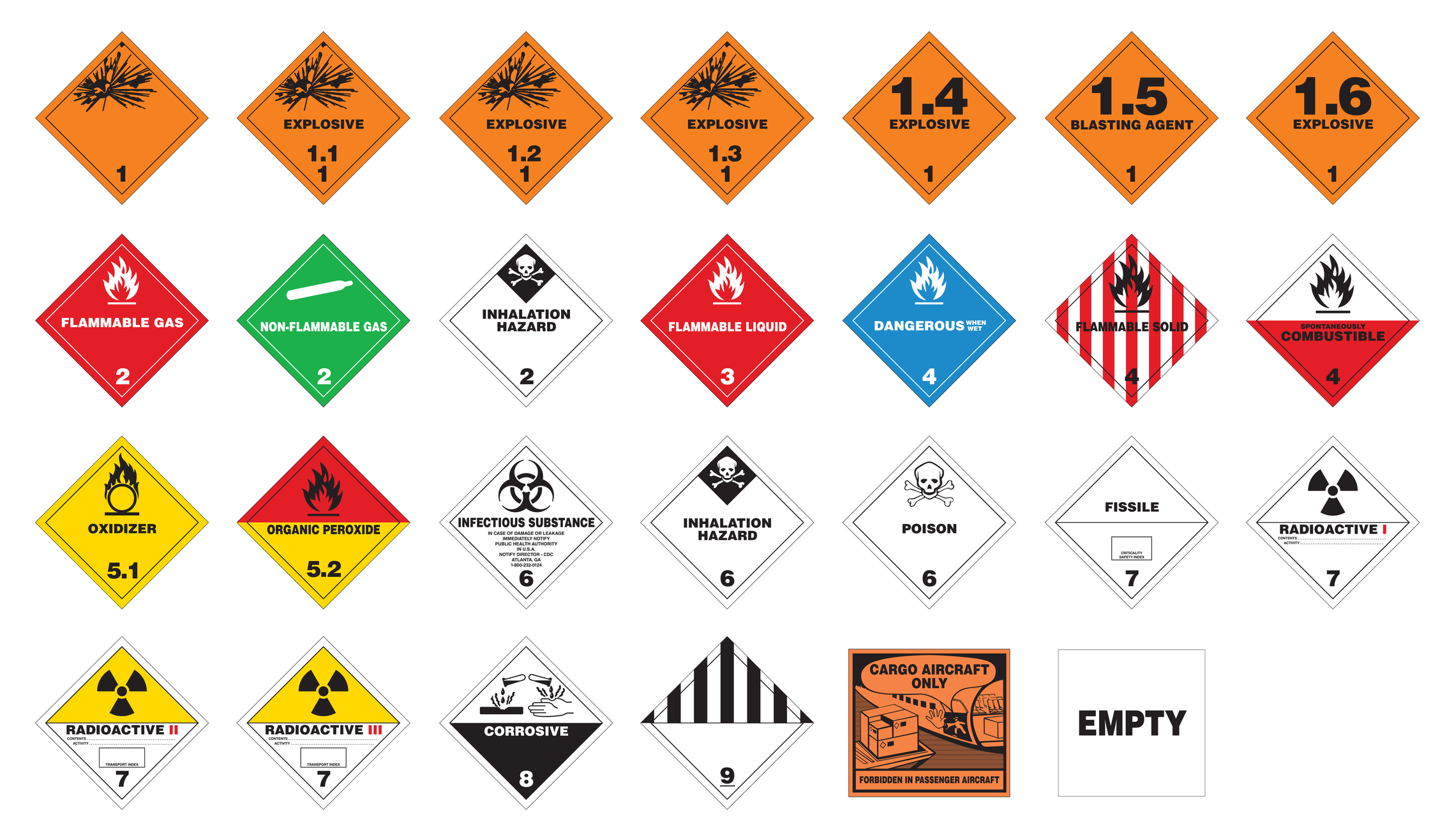
The Carriage of dangerous goods and marine pollutants in sea-going ships is respectively regulated in the International Convention for the Safety of the Life at Sea (SOLAS) and the International Convention for the Prevention of pollution from Ships (MARPOL).
Relevant parts of both SOLAS and MARPOL have been worked out in great detail and are included in the International Maritime Dangerous Goods (IMDG) Code, thus making this Code the legal instrument for maritime transport of dangerous goods and marine pollutants. As of 1st January 2004, the IMDG Code will become a Mandatory Requirement.
Classification of Dangerous Goods :For all modes of transport (Sea, Air, Rail, Road and Inland Waterways) the classification (grouping)of dangerous goods, by type of risk involved, has been drawn up by the UNITED NATIONS Committee of Experts on the Transport of Dangerous Goods (UN).
The transportation of dangerous goods is controlled and governed by a variety of different regulatory regimes, operating at both the national and international levels. Prominent regulatory frameworks for the transportation of dangerous goods include the United Nations Recommendations on the Transport of Dangerous Goods, ICAO's Technical Instructions, IATA's Dangerous Goods Regulations and the IMO's International Maritime Dangerous Goods Code. Collectively, these regulatory regimes mandate the means by which dangerous goods are to be handled, packaged, labelled and transported.

Dangerous goods are solids, liquids, or gases that can harm people, other living organisms, property, or the environment. They are often subject to Chemical Regulations. In the United States and sometimes in Canada dangerous goods are more commonly known as hazardous materials, (abbreviated as HAZMAT or HazMat). "HazMat teams" are personnel specially trained to handle dangerous goods. Dangerous goods include materials that are Radioactive, Flammable, Explosive, Corrosive, Oxidizing, Asphyxiating, Biohazards, Toxic, Pathogenic, Or Allergenic. Also included are physical conditions such as compressed gases and liquids or hot materials, including all goods containing such materials or chemicals, or may have other characteristics that render them hazardous in specific circumstances.
The multitude of dangerous goods regimes across the world and the complexity of dangerous goods classifications and regulations render compliance a particularly difficult task.
1. Explosives
2. Gases
3. Flammable Liquids
4. Flammable Solids
5. Oxidizing Substances
6. Toxic & Infectious Substances
7. Radioactive Material
8. Corrosives
9. Miscellaneous Dangerous Goods

1.1 - Explosives with a mass explosion hazard. (Nitro - Glycerin / Dynamite)
1.2 - Explosives with a blast/projection hazard.
1.3 - Explosives with a minor blast hazard. (Rocket Propellant, Display Fireworks)
1.4 - Explosives with a major fire hazard. (Consumer Fireworks, Ammunition)
1.5 - Blasting agents. (Explosion Similar to 1.1)
1.6 - Extremely insensitive explosives.
Reason For Regulation :
Explosives are capable by chemical reaction of producing gases at temperatures, pressures and speeds as to cause catastrophic damage through force and/or of producing otherwise hazardous amounts of heat, light,sound, gas or smoke.
Commonly Transported Explosives :
Ammunition/cartridges, Fireworks/pyrotechnics, Flares, Blasting caps / detonators, Fuse, Primers, Explosive charges (blasting, demolition etc.), Detonating cord, Air bag inflators, Igniters, Rockets, TNT / TNT compositions, RDX / RDX compositions, PETN / PETN compositions, etc.

2.1 - Flammable Gas :
Gases which ignite on contact with an ignition source, such as acetylene and hydrogen.
2.2 - Non-Flammable Gases :
Gases which are neither flammable nor poisonous. Includes the cryogenic gases/liquids (temperatures of below -100°C) used for cryopreservation and rocket fuels, such as nitrogen and neon.
2.3 - Poisonous / Toxic Gases :
Gases liable to cause death or serious injury to human health if inhaled; examples are fluorine, chlorine, and hydrogen cyanide.
Reason For Regulation :
Gases are capable of posing serious hazards due to their flammability, potential as asphyxiates, ability to oxidize and/or their toxicity or corrosiveness to humans.
Commonly Transported Explosives :
Aerosols, Compressed air, Hydrocarbon gas-powered devices, Fire extinguishers, Gas cartridges, Fertilizer ammoniating solution, Insecticide gases, Refrigerant gases, Lighters, Acetylene / Oxyacetylene, Carbon dioxide, Helium / helium compounds, Hydrogen / hydrogen compounds, Oxygen / oxygen compounds, Nitrogen / nitrogen compounds, Natural gas, Oil gas, Petroleum gases, Butane, Propane, Ethane, Methane, Dimethyl ether, Propene / propylene, Ethylene, etc.

A flammable liquid (Class 3) means a liquid having a flash point of not more than 60.5°C (141°F), or any material in a liquid phase with a flash point at or above 37.8°C (100°F) that is intentionally heated and offered for transportation or transported at or above its flash point in a bulk packaging.
If any liquid with a flash point greater than 35°C (95°F) and with a fire point greater than 100°C (212°F) according to ISO 2592.
Flammable liquids are capable of posing serious hazards due to their volatility, combustibility and potential in causing or propagating severe conflagrations.
Commonly Transported Flammable Liquids :
Acetone / acetone oils, Adhesives, Paints / lacquers / varnishes, Alcohols, Perfumery products, Gasoline / Petrol, Diesel fuel, Aviation fuel, Liquid bio-fuels, Coal tar / coal tar distillates, Petroleum crude oil, Petroleum distillates, Gas oil, Shale oil, Heating oil, Kerosene, Resins, Tars, Turpentine, Carbamate insecticides, Organ chlorine pesticides, Organ phosphorus pesticides, Copper based pesticides, Esters,Ethers, Ethanol, Benzene, Butanols, Dichloropropenes, Diethyl ether, Isobutanols, Isopropyl, Methanol,Octanes, etc.

4.1 - Flammable Solids :
Solid substances that are easily ignited and readily combustible (nitrocellulose, magnesium, safety or strike-anywhere matches).
4.2 - Spontaneously Combustible :
Solid substances that ignite spontaneously (aluminium alkyls, white phosphorus).
4.3 - Dangerous When Wet :
Solid substances that emit a flammable gas when wet or react violently with water (sodium, calcium, potassium, calcium carbide).
Reason For Regulation :
Flammable solids are capable of posing serious hazards due to their volatility, combustibility and potential in causing or propagating severe conflagrations.
Commonly Transported Flammable Solids :
Alkali metals, Metal powders, Aluminium phosphide, Sodium batteries, Sodium cells, Firelighters, Matches, Calcium carbide, Camphor, Carbon, Activated carbon, Celluloid, Cerium, Copra, Seed cake, Oily cotton waste, Desensitized explosives, Oily fabrics, Oily fibres, Ferro cerium, Iron oxide (spentIron sponge/direct-reduced iron (spent), Met aldehyde, Naphthalene, Nitrocellulose, Phosphorus; Sulphur, etc.

5.1 - Oxidizing Agents :
other than organic peroxides (calcium hypochlorite, ammonium nitrate, hydrogen peroxide, potassium permanganate).
5.2 - Organic Peroxide / Oxidizing Agent :
Organic peroxides, either in liquid or solid form (benzoyl peroxides, cumene
hydro peroxide).
Organic peroxides are thermally unstable and may exude heat whilst
undergoing exothermic autocatalytic decomposition.
Additionally, organic peroxides may be liable to explosive decomposition,
burn rapidly, be sensitive to impact or friction,
react dangerously with other substances or cause damage to eyes.
Commonly Transported Oxidizers, Organic Peroxides :
Chemical oxygen generators, Ammonium nitrate fertilizers, Chlorates, Nitrates, Nitrites, Perchlorates, Permanganates, Persulphates, Aluminium nitrate, Ammonium dichromate, Ammonium nitrate,Ammonium persulphate, Calcium hypochlorite, Calcium nitrate, Calcium peroxide, Hydrogen peroxide,Magnesium peroxide, Lead nitrate, Lithium hypochlorite, Potassium chlorate, Potassium nitrate,Potassium chlorate, Potassium perchlorate, Potassium permanganate, Sodium nitrate, Sodium per sulphate, etc.

6.1a - Toxic Substances :
which are liable to cause death or serious injury to human health if inhaled, swallowed or by skin absorption (potassium cyanide, mercuric chloride).
6.1b - (Now PG III) Toxic Substances :
which are harmful to human health (N.B this symbol is no longer authorized by the United Nations) (pesticides, methylene chloride).
6.2 - Bio-Hazardous Substances :
the World Health Organization (WHO) divides this class into two
categories:
Category A : Infectious; and
Category B : Samples (virus cultures, pathology specimens, used intravenous
needles).
Dangerous goods regulations define pathogens as microorganisms, such as
bacteria, viruses, rickettsia, parasites and
fungi, or other agents which can cause disease in humans or animals.
Commonly Transported Toxic Substances, Infectious Substances :
Medical/Biomedical waste, Clinical waste, Biological cultures / samples / specimens, Medical cultures / samples / specimens, Tear gas substances, Motor fuel anti-knock mixture, Dyes, Carbamate pesticides, Alkaloids, Allyls, Acids, Arsenates, Arsenites, Cyanides, Thiols / mercaptans, Cresols, Barium compounds, Arsenics / arsenic compounds, Beryllium/ beryllium compounds, Lead compounds, Mercury compounds, Nicotine / nicotine compounds, Selenium compounds, Antimony, Ammonium met vanadate, Adiponitrile, Chloroform, Dichloromethane, Hexachlorophene, Phenol, Resorcinol, etc.

Radioactive Substances :
comprise substances or a combination of substances which emit ionizing
radiation (uranium, plutonium). A radionuclide is an atom
with an unstable nucleus and which consequently is subject to radioactive
decay.
Whilst undergoing radioactive decay radionuclides emit ionizing radiation,
which presents potentially severe risks to human health.
Commonly Transported Toxic Substances, Infectious Substances :
Radioactive ores, Medical isotopes, Yellowcake, Density gauges, Mixed fission products, Surface contaminated objects, Caesium radionuclides / isotopes, Iridium radionuclides / isotopes, Americium radionuclides / isotopes, Plutonium radionuclides / isotopes, Radium radionuclides / isotopes, Thorium radionuclides / isotopes, Uranium radionuclides / isotopes, Depleted uranium / depleted uranium products, Uranium hexafluoride, Enriched Uranium, etc.

Corrosive Substances Are Substances That Can Dissolve Organic Tissue Or Severely Corrode Certain Metals :
8.1 Acids :
Sulphuric Acid, Hydrochloric Acid
8.2 Alkalis :
Potassium Hydroxide, Sodium Hydroxide
Corrosives cause severe damage when in contact with living tissue or, in the
case of leakage, damage or destroy surrounding materials.
Commonly Transported Toxic Substances, Infectious Substances :
Acids/acid solutions, Batteries, Battery fluid, Fuel cell cartridges, Dyes, Fire extinguisher charges, Formaldehyde, Flux, Paints, Alkyl phenols, Amines, Polyamines, Sulphides, Polysulphides, Chlorides, Chlorosilanes, Bromine, Cyclohexylamine, Phenol / carbolic acid, Hydrofluoric acid, Hydrochloric acid, Sulphuric acid, Nitric acid, Sludge acid, Hydrogen fluoride, Iodine, Morphine, etc.

A material which presents a hazard during transportation but which does not meet the definition of any other hazard class. This class includes: Any material for an elevated temperature material, a hazardous substance, a hazardous waste, or a marine pollutant.
Commonly Transported Toxic Substances, Infectious Substances :
Dry ice / car dice / solid carbon dioxide, Expandable polymeric beads / polystyrene beads, Ammonium nitrate fertilizers, Blue asbestos / crocidolite, Lithium ion batteries, Lithium metal batteries, Battery powered equipment, Battery powered vehicles, Fuel cell engines, Internal combustion engines, Vehicles, Magnetized material, Dangerous goods in apparatus, Dangerous goods in machinery, Genetically modified organisms, Genetically modified micro-organisms,Chemical kits, First aid kits, Life saving appliances, Air bag modules, Seatbelt pretensions, Plastics moulding compound, Castor bean plant products, Polychlorinated biphenyls, Polychlorinated terphenyls, Dibromodifluoromethane, Benz aldehyde, etc.
